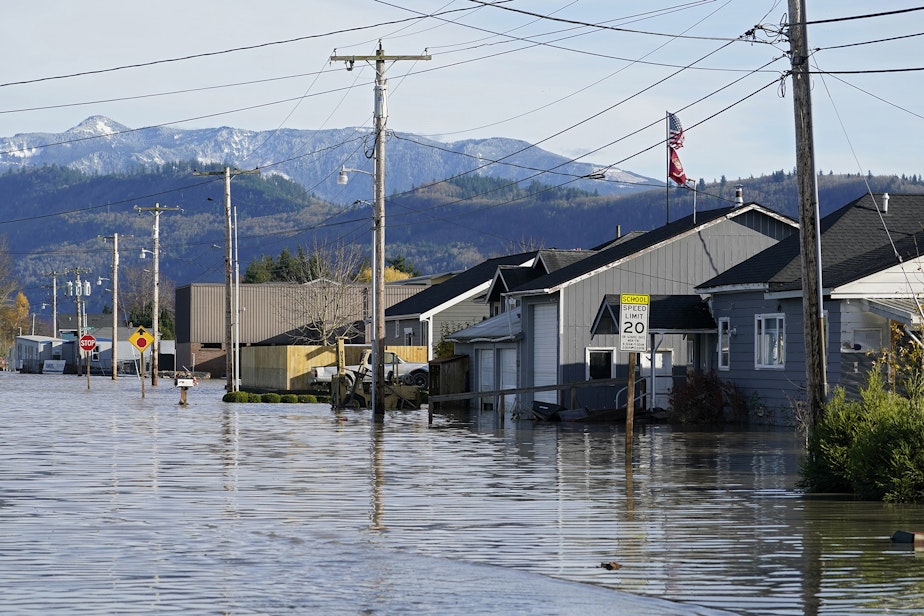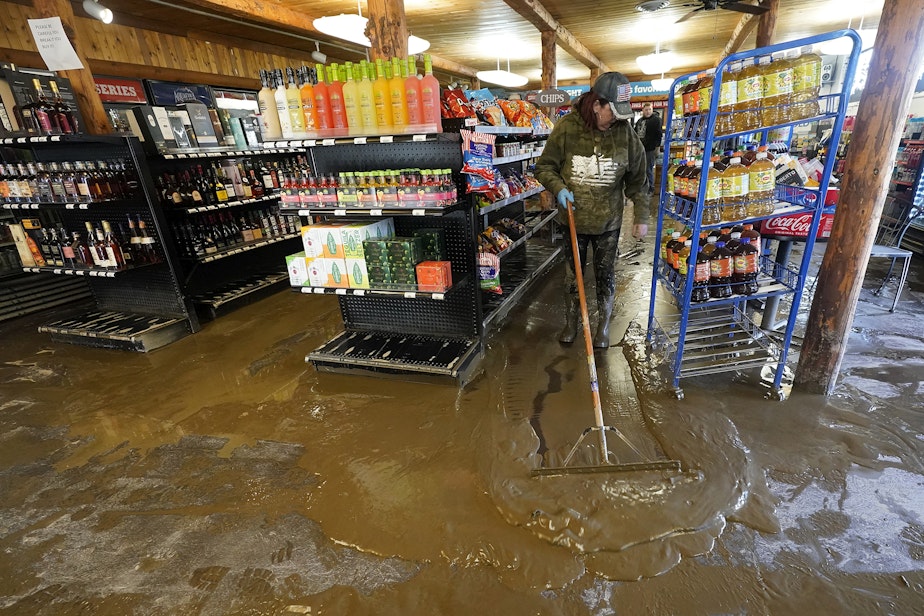This won't be the last time this small Washington town goes under water

Residents of a small Washington border town say the Nooksack River unleashed a flood unlike any they’ve ever seen before this week.
Locals volunteered their own boats, tractors and other heavy machinery to aid in the evacuation of their waterlogged neighbors. Mayor Kyle Christensen says if they hadn’t stepped up, “we wouldn’t be where we are today.”
In other words, the town may have lost more than buildings or belongings; no lives were lost to the deluge.
The area along the U.S.-Canada border has been flooded before. In some ways, this flood was a case of déja vu. But in the bigger picture, it represents what climate scientists say will be the norm in years ahead.
A massive wind and rainstorm that began on Friday triggered flooding and mudslides near the Canadian border. Thousands lost power, and roads were cut off as residents in hard-hit areas were evacuated.
On Monday, Washington Gov. Jay Inslee declared a severe weather state of emergency for 14 counties, including Whatcom where Sumas is located.
Sponsored
Dramatic images show the extent of the damage. Drone footage from the city of Bellingham captured people using kayaks along the flooded streets, navigating abandoned cars that were completely submerged.
Sumas Mayor Kyle Christensen spoke to KUOW as he drove down his flooded streets, surveying the damage. He’s done an interview like this before. In February 2020, he took questions as he evaluated flood damage at his own home.
At the time, Christensen said Sumas hadn’t experienced that level of flooding since 1990.
Mayor Kyle Christensen, February 2020
"My house is kind of on an island right now. So, I have to wear chest-waders to get in and out of my house to get to my vehicle to make it to city hall and to do my job as mayor."
Now, his town is again coping with conditions they’ve never seen before. “This flood was worse than what we saw [last year],” he says. “There’s just a lot of people who have been devastated again.”
Sponsored
The flood damaged more than homes. As the water rose Tuesday, it pushed and derailed several BNSF freight-train cars that were waiting at a rail yard; Christensen says 12 cars were derailed.
In a statement to KUOW, BNSF spokesperson Lena Kent says the cars tipped when the flood washed out the ballast beneath their tracks; the ground was made unstable without that material.
Kent says six of the cars contained asphalt, but no materials were compromised.
"Due to heavy rains and flooding, we had rail cars that were sitting in the yard when the ballast washed out beneath the tracks," Kent said. "Six of those cars contained asphalt and subsequently tipped on their side."
No one was injured, as far as Christensen knows, but the lingering water has kept crews from reaching the cars and immediately inspecting the tracks; a BNSF spokesperson told The Associated Press the tracks could reopen within a week, though that depends on when the water recedes.
Sponsored
Much of the town’s recovery will depend on that.
Christensen said at least 75% of homes in Sumas were damaged; officials won’t be able to get a complete picture until the floodwaters recede. He’s moved since he last spoke with KUOW, trudging through chest-high water in waders to get to his truck. His home today is on higher ground, protecting it from the rising waters.
He can’t move the entire town, though.
The severe weather was caused by an "atmospheric river" that pelted the Pacific Northwest with heavy rain and strong winds for days.
Sponsored
An atmospheric river is a long, narrow section of moist air that releases rain or snow as it makes landfall. from the Pacific Ocean in the atmosphere.
Climate scientists say the atmospheric river and resulting floods throughout the region are merely a dress rehearsal for hotter decades ahead.
Guillaume Mauger at the University of Washington works with models that try to predict what a hotter climate will do to rivers and shorelines.
He said this week’s destructive floods do have an upside of sorts: “All those things are really valuable to be able to see firsthand.”
Sponsored
Sumas was not the only testing ground.
The Lummi Reservation was cut off after a massive landslide blocked a stretch of I-5.
People in Ferndale fled the cresting Nooksack River by boat as it overtook downtown. Bellingham had its rainiest three days on record, with nearly six inches recorded. Some parts of the Cascades and Olympics got as much as 15 inches in the last week.
And a pump station in the nearby city of Abbotsford, B.C., was so overwhelmed it threatened to cause even more catastrophic flooding; Abbotsford is just 15 miles away from Sumas.
As the Northwest warms up, scientists say that’ll get worse. That’s because warmer air can hold — and dump — more water.

Short of packing everyone up and moving out of flood-range, how could Sumas be made more flood-resistant?
Removing sediment that has built up in local waterways and improving the town’s water storage capacity is on his short list; Christensen told KUOW he was meeting with Washington Governor Jay Inslee Wednesday to request support from the state, for crews responding to the immediate situation and for the future.
He’s optimistic, but he also knows there’s more to what he’s asking than simply lending a hand to neighbors in need: “All of these things take money. We’re just going to try to push to get what we can from all the different agencies.”
KUOW’s Natalie Newcomb and John Ryan contributed to this report.





